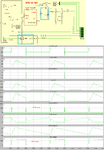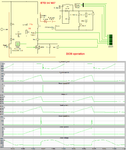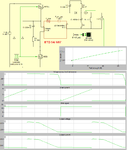E-design
Advanced Member level 5
The simulation below with a magnetic saturation model, show how saturation can occur with too small air gapped core. Bottom trace RH picture show gap reduced from 1 mm to 0.5 mm.
- - - Updated - - -
Another set of results with a larger ETD 44 core and 0.5 mm gap.
- - - Updated - - -
The result of omitting the snubber, damper or both.
- - - Updated - - -
Another set of results with a larger ETD 44 core and 0.5 mm gap.
- - - Updated - - -
The result of omitting the snubber, damper or both.





